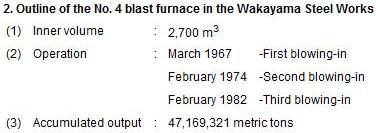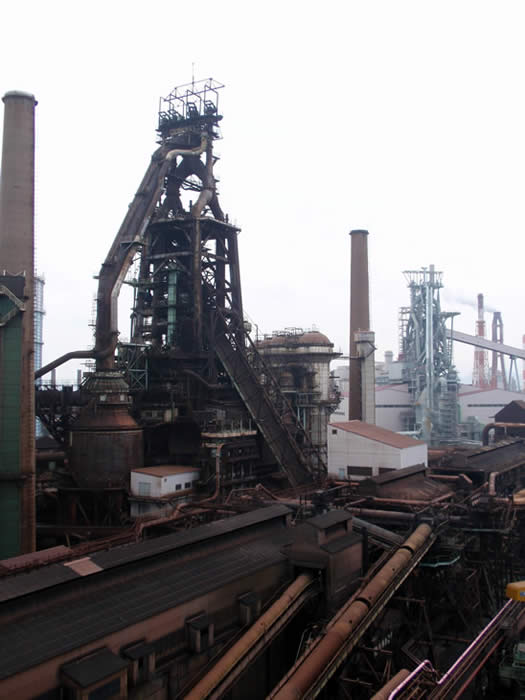Wakayama Steel Works' No. 4 Blast Furnace Was Blown-Out,
after Achieving the World's Longest Operating Life
of 10,001 days (27 years and 4 months)
2009.07.13
- Sumitomo Metal Industries, Ltd.
On July 11, 2009, Sumitomo Metal Industries, Ltd. (Sumitomo Metals) conducted a blowing-out of the Wakayama Steel Works' No. 4 blast furnace. The No.4 blast furnace had run for 10,001 days (27 years and 4 months) since its blowing-in on February 23, 1982 after the third relining, and achieved the world record for the longest operating life. With the blowing-out of the No.4 blast furnace, a blowing-in of the new No.1 blast furnace is scheduled on July 17.
1. Reasons for achieving the world's longest operating life
Sumitomo Metals conducted the relining and blowing-in of the Wakayama Steel Works' No. 4 blast furnace in 1982 with the initial plan to operate it for 7 years. Since then, we have developed a variety of new technologies and conducted inspections and maintenance works to ensure life extension. As a result, the No. 4 blast furnace has achieved the world's longest operating life. The main technologies that contributed to achieving the world record are described below.
(1) Replacing staves
The inner wall of the body of a blast furnace has staves (cooling devices made of ferrous castings) on which heat-resistant bricks are placed. Previously when staves got damaged, we could not repair them, unless we blew out the furnace to be relined.
However, the technology to replace staves at a time of scheduled maintenance work has separated the operating life of staves from the operating life of a blast furnace.
(2) Inhibiting erosion of bricks on the bottom of a blast furnace
Bricks that are installed on the bottom of a furnace may get eroded by high-temperature (about 1,500ºC) molten pig iron and slag but cannot be replaced unless the furnace was blown-out and relined.
We have developed new technologies to extend an operating life of heat-resistant bricks at the bottom of a furnace by monitoring the flow of molten pig iron and slag inside the blast furnace through the control of coke's characteristics, molten pig iron's liquidity, and raw materials' weight balance within the blast furnace.
(3) Partially replacing bricks of a hot stove
The No. 4 blast furnace had installed three hot stoves that were required to alternately transmit high-temperature (1,250ºC) hot air to the blast furnace. The conventional practice was to blow-out the blast furnace to conduct a major repair of a hot stove.
Sumitomo Metals has developed technologies to conduct a major repair (requiring about one month) of a hot stove. They include a technique to minimize a decline in temperature of the blast furnace by air transmission from the remaining two hot stoves; a technique to maintain the temperature of the heat-resistance bricks at a certain level during the major repair (low temperature induces silica brick to break.); and a technique to complete the repair work in a short period of time. Various technological developments have separated the operating life of a hot stove from the operating life of a blast furnace.
Sumitomo Metals has offered licensing and technical support for replacement of staves to other steel companies in Japan and overseas and has contributed to prolonging blast furnace life at other companies.


No.4 Blast Furnace, Wakayama Steel Works
(The new No.1 Blast Furnace is seen in the rear.)
